|
https://spaceweather.com/
SUNSPOT NUMBERS REMAIN HIGH: So far this month, average sunspot numbers are hovering between 200 and 250. If this continues for another 12 days, August 2024 will end up as the spottiest month in more than 20 years, rivaling the peak of old Solar Cycle 23. No mainstream forecasters predicted that Solar Cycle 25 (the current cycle) would be so strong, but the sun has its own plans. Solar flare alerts: SMS Text WAITING FOR THE NEXT SPACEX SPIRAL: For more than a year, Zach Goldberg has been wondering what he saw. The aurora photographer was camping in Denali National Park in April 2023 when, out of nowhere, a giant blue spiral pinwheeled across the night sky. "We had no idea what it was," says Goldberg. "Fortunately, we already had our cameras out for the auroras." This is what he saw: 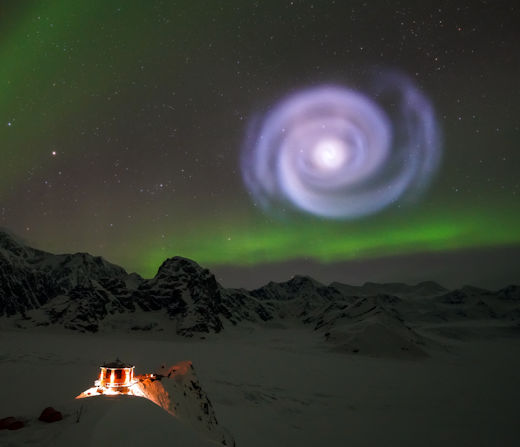 Mystery solved: It was a "SpaceX spiral." On April 15, 2023, SpaceX launched a Falcon 9 rocket from California's Vandenberg Space Force Base. It carried 51 small satellites to Earth-orbit, a mission known as Transporter-7. When the rocket's discarded upper stage passed over Alaska, it vented its unused fuel. Spirals are a common side-effect of Transporter rideshare missions. Within these Falcon 9 rockets, satellites from various clients have different destinations. SpaceX must rotate the rocket's second stage for deployment. The de-orbit burn and fuel dump naturally spirals. Another spiral appeared on March 5, 2024, when Transporter-10 deployed 53 satellites:  "I caught this in Akureyri, Iceland, around 1 a.m. local time," says photographer Shang Yang. "It looked otherworldly against the Northern Lights!" When will it happen again? Possibly in two months. The Transporter-12 mission is currently scheduled for October 2024. It could dump its fuel into a northern autumn sky filled with equinox auroras and Orionid meteors. Arctic photographers are encouraged to monitor the launch schedule and submit your images here. |
|
|
|
|
https://earthsky.org/sun/sun-news-activity-solar-flare-cme-aurora-updates/
Pics at above link. Sun news August 20: Solar activity is in the periphery Today’s top story: The sun brought us a day similar to yesterday, with moderate flaring and most of the action in the periphery. During our observation period, the sun produced three M flares. We notice that solar activity is mainly in the periphery via dancing long-lasting prominences. In particular, it brings attention to fiery prominences on the southwest horizon. This activity is moving out of sight on the western limb (edge), meaning no action is expected to move our way…for now. Stay tuned. Last 24 hours: Three M flares kept solar activity at moderate in the past day. During our observation period, between 11 UTC yesterday to 11 UTC today, the sun produced 13 flares, three M and 10 C flares. The same active sunspot region produced all three M flares: AR3796. The first was the largest period: an M3.7 flare at 21:52 UTC on August 19. An R1 (minor) radio blackout was affected an area of the Pacific Ocean over Hawaii. The lead flare producer was Sunspot region AR3796, who, besides the three Ms, produced another three Cs for six flares during the day. The list of M flares is: • M3.7 at 21:52 UTC on August 19 from AR3796. R1 (minor) radio blackout over Hawaii. The largest. • M1.0 at 23:11 UTC on August 19 from AR3796. R1 (minor) radio blackout over the Pacific Ocean west of Hawaii. • M1.2 at 04:48 UTC on August 20 from AR3796. R1 (minor) radio blackout over Vietnam. Today, sunspot region AR3784 remains the largest and most magnetically complex, beta-gamma-delta, indicating a possibility for more strong flaring. Now located close to the northwest limb (edge), it will soon rotate out of view, but in the meantime, it could produce more M or even an X flare. AR3790 and AR3796 are simpler beta-gamma regions, and the rest of the sunspot regions are stable, with alpha or beta configurations. The sun has 12 active regions, including two new regions, AR3797 and AR3798. Next 24 hours: The chance for C flares is 99%. The chance for M flares is 65%. The chance for X flares is 20%. Next expected CME: No new Earth-directed coronal mass ejections (CMEs) were observed in the available coronagraph imagery. Current geomagnetic activity: Earth’s magnetic field is quiet at the time of this writing (11 UTC on August 20). Mostly quiet conditions are expected for the rest of today, August 20 through August 21. By August 22, weak fast solar wind from a coronal hole could potentially move into a geoeffective position, increasing the chances of additional unsettled to active periods. Sun news August 19: An average day on a star at Solar Max Today’s top story: Today is an average day on our active star. That is, the sun is now at or near solar maximum, the peak of its 11-year cycle of activity. Today, flaring is moderate, with three smaller M flares, even though the sun is covered with 11 sunspot groups. The solar limb (edge) has both stable and active prominences and scattered jets of solar stuff shooting out of various active regions. Looking at the sun farther out, several coronal mass ejections (CMEs) are flying into space, but few or none are Earth-directed. An average day on an active star during solar maximum looks like this. Some days and weeks can be filled with multiple forms of high activity. Some days, like today, will only show moderate activity both at the sun and on Earth. These average periods come and go. Enjoy your Monday and stay tuned for the next solar excitement with EarthSky. Last 24 hours: Sun activity has been moderate during the past day (11 UTC yesterday to 11 UTC today), because of three M flares. The sun produced 12 flares, the three M and nine C flares. All three M flares were M1.4. The first two were from AR3796, and the third from AR3785. All three produced an R1 (minor) radio blackout. The list of M flares is: • M1.4 at 21:07 UTC on August 18 from AR3796. R1 (minor) radio blackout over the Pacific Ocean. • M1.4 at 00:00 UTC on August 19 from AR3796. R1 (minor) radio blackout over the Pacific Ocean. • M1.4 at 09:36 UTC on August 19 from AR3785. R1 (minor) radio blackout over Africa. AR3784 region remains the largest and most magnetically complex region on the sun; it still has a beta-gamma-delta magnetic complexity, indicating a possibility for more strong flaring. AR3790 and AR3796 have a slightly simpler beta-gamma region, and the remaining sunspot regions are even simpler, either alpha or beta. In addition to flaring, the sun has a variety of small prominences and looks active around the solar limb (edge). Most notable is a stable prominence on the southern limb (edge) near the pole. Two new regions were numbered AR3795 and AR3796. The sun has 11 active regions on its Earth-facing side. Next 24 hours: The chance for C flares is 99%. The chance for M flares is 70%. The chance for X flares is 20%. Next expected CME: No new Earth-directed coronal mass ejections (CMEs) were observed in the available coronagraph imagery. Current geomagnetic activity: Earth’s magnetic field is quiet at the time of this writing (11 UTC on August 19). Mostly unsettled conditions are expected today. Quiet conditions are expected on August 20-21. |
|
|
|
|
https://earthsky.org/sun/sun-news-activity-solar-flare-cme-aurora-updates/
Sun news August 21: Active prominence, increased flaring Today’s top story: An as-of-yet-unnumbered region on the southeast limb brings an active prominence region into view with multiple jets of solar stuff. Flare production has increased over the last 24 hours, going from 13 to 24 flares. Two M flares kept sun activity at moderate levels. AR3784 rotates out of view while AR3790 approaches the disk center, the largest region on the sun. Helioseismology shows potential active regions on the sun’s farside that could bring us more Earth-directed activity. Stay tuned. Last 24 hours: Two M flares observed during our observation from 11 UTC yesterday to 11 UTC today, kept sun activity at moderate levels. The sun produced 25 flares, the two M and 23 C flares. The largest flare was the first M, an M1.3, at 17:08 UTC on August 20 from AR3785. An R1 (minor) radio blackout affected an area over the Atlantic Ocean. The second M was an M1.1 at 6:02 UTC on August 21 from AR3796 with an R1 (minor) radio blackout over the Bay of Bengal. The lead flare producer of the period was sunspot region AR3784, with nine C flares. The sun has 11 numbered active regions. AR3784 lost its delta magnetic complexity due to its position on the northwest solar limb (edge). Because its magnetic field is difficult to measure, it is listed as only a beta-gamma region. Regions AR3790 and AR3796 are beta-gamma regions. The remaining sunspot regions are simple with alpha or beta configurations. Next 24 hours: The chance for C flares is 99%. The chance for M flares is 65%. The chance for X flares is 20%. Next expected CME: No new Earth-directed coronal mass ejections (CMEs) were observed in the available coronagraph imagery. Current geomagnetic activity: Earth’s magnetic field is quiet at the time of this writing (11 UTC on August 21). Mostly quiet conditions are expected for the rest of today. August 22 may see some unsettled conditions due to a weak fast solar wind from a coronal hole that has moved into a geoeffective position. |
|
|
|
|
Science hype. Wake us up when our sun betelgeuseses.
|
|
|
|
|
|
|
Aurora is hiding up near Canada again for a bit.
I'm sure we'll see some nice ones this winter as the solar cycle peak is coming. |
|
|
The person who complains most, and is the most critical of others has the most to hide.
All truth passes through three stages. First, it is ridiculed. Second, it is violently opposed. Third, it is accepted as being self-evident. |
|
https://spaceweather.com/
SUNSPOT NUMBERS AT A 20-YEAR HIGH: For the second month in a row, the monthly-average sunspot number is cruising toward a 20-year high. The current value, around 230, would eclipse every month since Sept. 2001, which occured during the peak of old Solar Cycle 23. The current cycle (Solar Cycle 25) was not supposed to be this strong, and it may become even stronger before Solar Max is finished. Solar flare alerts: SMS Text AN EXPLOSION OF AURORAS: At first glance, you might think these images have been Photoshopped. They have not. At the stroke on midnight on Aug. 11/12, Canadian photographer Alan Dyer witnessed an explosion of brightly colored auroras: 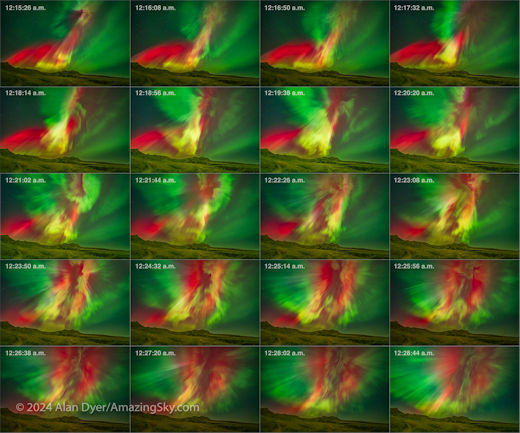 "The event began with intense reds sweeping in from the east and engulfing the sky," says Dyer, who recorded the display from Grasslands National Park in southwest Saskatchewan. "The greens followed, mixing with the reds to produce a bouquet of yellows and oranges." It was over in less than 15 minutes. Researchers call this an "auroral substorm." First recognized in the early 1960s by a young Japanese physicist named Shun-ichi Akasofu, substorms have been studied for more than 50 years, yet to this day they are almost entirely unpredictable. Substorms are caused by explosions in Earth's magnetic tail. This movie from NASA shows the process in action: https://vimeo.com/1001472030 The explosion, caused by magnetic reconnection in the overstretched tail, shoots a beam of energetic electrons and protons directly toward Earth. Auroras mark the broad spot where the particles strike Earth's atmosphere. "The substorm was at true midnight when we are looking straight down the magnetotail," says Dyer. At the time, a strong geomagnetic storm was underway, so Earth's magnetic tail was being stretched--a lot. It was the perfect setup for a blast. |
|
|
|
|
https://earthsky.org/sun/sun-news-activity-solar-flare-cme-aurora-updates/
Sun news August 22: Sun activity reaches high levels Today’s top story: Solar activity is high with an M5.1 flare from AR3796. This is one of many actions happening on our star. A combination of far-sided activity and helioseismology reveals one or more sunspot regions that could kick things up a notch. GOES-16 observed a huge prominence around 7 UTC, August 22, slightly west of the North Pole. AR3789 is still making its presence known, spitting out plasma jets over the northwest limb (edge). All this while a large, more stable prominence continues its dance on the southeast limb (edge) just east of the South Pole. Stay tuned for more. Last 24 hours: Solar activity reached a high level during the past day with an M5.1 flare. From 11 UTC yesterday to 11 UTC today the sun produced 15 flares, two M, and 13 C flares. The largest event was the M5.1 at 22:08 UTC on August 21 from AR3796. An R2 (moderate) radio blackout affected an area over Hawaii. Region AR3796 also produced an M1.5 flare at 10:42 UTC, which caused an R1 radio blackout over Africa. The lead flare producers were regions AR3784 and AR3796, each with four flares. The active region of AR3784 rotated over the southwest limb (edge). Regions AR3790 and AR3796 retained a beta-gamma magnetic complexity. The remaining regions on the solar disk have simple alpha or beta configurations. The sun has ten numbered active regions on the Earth-facing side. There is a newcomer in the southeast quadrant, AR3799. An incoming region on the northeast limb (edge) may be the first region numbered in the 3800s. Next 24 hours: The chance for C flares is 99%. The chance for M flares is 60%. The chance for X flares is 20%. Next expected CME: No new Earth-directed coronal mass ejections (CMEs) were observed in the available coronagraph imagery. Current geomagnetic activity: Earth’s magnetic field is quiet at the time of this writing (11 UTC on August 22). Earlier yesterday an unsettled period was observed. A weak fast solar wind stream from a coronal hole that has moved into a geoeffective position, could increase conditions to unsettled levels, with possible active periods today. However, mostly quiet conditions are expected on August 23-24. |
|
|
|
|
https://earthsky.org/sun/sun-news-activity-solar-flare-cme-aurora-updates/
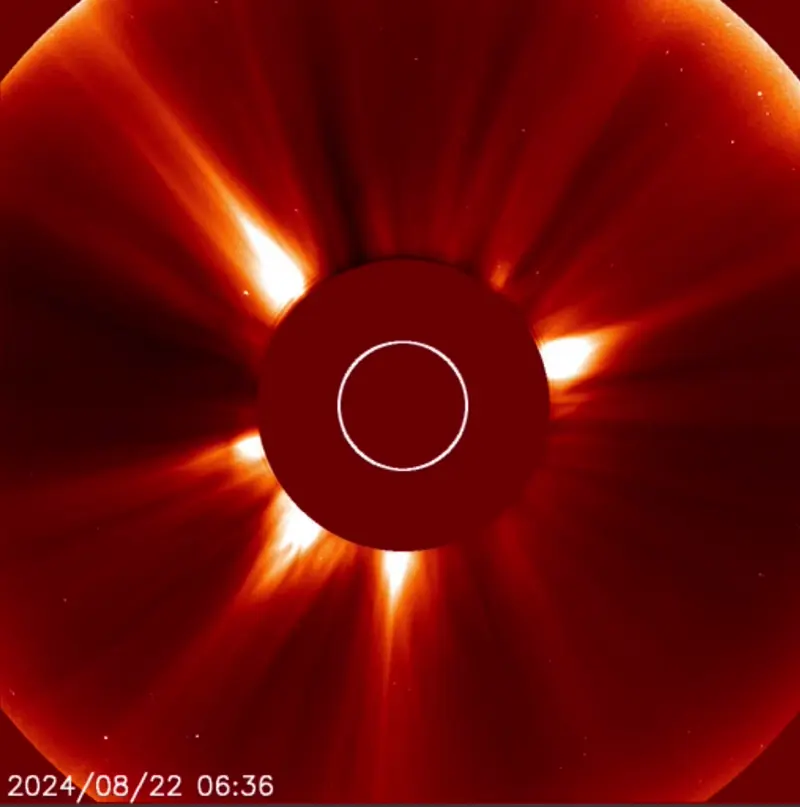 Sun news for August 23-24, 2024. The LASCO C2 and C3 coronagraphs from SOHO spacecraft and the ENLIL solar system model show a barrage of coronal mass ejections (CMEs). Looking at the coronagraphs, one would think this means the Earth-facing sun is super active, but the solar disk and ENLIL reveal that this is all mostly back-sided. This shows us that some very active regions may soon be rotating into view. Image via NASA. Sun news August 23: Intense activity on the sun’s far side Today’s top story: The sun is very active right now, but all is not what it might seem. Observing our star with the SOHO spacecraft’s LASCO C2 and C3 coronagraphs, one can see a barrage of coronal mass ejections (CMEs) flying into space. But if you look a little closer using extreme-ultraviolet imagery from the Solar Dynamics Observatory (SDO), we see no notable CME activity on the solar disk. Combining all this data into the ENLIL solar system model, the real nature of this activity is revealed: it’s on the sun’s rear side. So the side of the sun facing away from Earth is very active right now, and some of the action could be rotating our way. Using helioseismology to look through the sun reveals that there are many potential active regions soon to rotate onto our side. Stay tuned, as we may see major solar activity in the middle of next week. And, in fact, some of that activity may already be here; today’s largest M flare is from one the newcomer regions, AR3801, which has just rotated into view. Last 24 hours: Solar activity reduced to moderate levels in the past day with two M flares but flaring production increased notably. During our observation period from 11 UTC yesterday to 11 UTC today, the sun produced 22 flares: two M and 20 C flares. The first and largest M was an M3.5 at 3:41 UTC on August 23 from active region AR3801. An R1 (minor) radio blackout affected an area over the Philippine Sea. The second M was an M1.0 at 4:18 UTC on August 23 from AR3800. An R1 (minor) radio blackout affected the Philippines. The lead flare producer was sunspot region AR3801 with eight flares: the largest M plus seven C flare. Active regions AR3790 and AR3796 retained their beta-gamma magnetic complexities and the largest sized regions are AR3790 and AR3792. The remaining regions have simple alpha or beta configurations and remain stable or are in decay. There are nine numbered active regions on the Earth-facing side. A couple of newcomers, one in the southeast quadrant labeled AR3800 and the incoming region on the northeast limb (edge) we mentioned yesterday, got the second label of the 3800s generation, AR3801. These two groups are very productive and AR3801 is today’s lead flare producer. We have to keep an eye on these active regions. Next 24 hours: The chance for C flares is 99%. The chance for M flares is 55%. The chance for X flares is 10%. Next expected CME: Intense coronal mass ejection (CMEs) activity was observed in LASCO C2 and C3 but the vast majority of the CMEs are far-sided explosions. None of them are Earth-directed. Current geomagnetic activity: Earth’s magnetic field is quiet at the time of this writing (11 UTC on August 23). sUnsettled period are anticipated during the rest of the day today as the weak fast solar wind stream from a coronal hole start to wane. Quiet conditions are expected on August 24-25. |
|
|
|
|
A little more on the significance of AR 3800. Pretty wild to me that the sun may still be ramping up this cycle, and we could potentially see another 3 years of activity at these levels.
|
|
|
|
|
https://spaceweather.com/
A CME IS COMING: But it's not a big one. The CME was hurled toward Earth during the early hours of Aug. 23rd by a puny C6-class solar flare. A NASA model predicts it will arrive on Aug 26th (1800 UT). The impact could spark a minor G1-class geomagnetic storm. CME impact alerts: SMS Text |
|
|
|
|
https://earthsky.org/sun/sun-news-activity-solar-flare-cme-aurora-updates/
Sun news August 25: Sun activity is high with eight M flares Today’s top story: The sun activity went up to high levels thanks to eight M flares produced during the past day. The largest an M5.1 at 20:12 UTC on August 23 from AR3800. It seems the high energetic action we saw from the far side of the sun started to turn around and it here and started to show on the Earth-facing side of our star. The two active regions we welcomed yesterday are the blueprint of flaring activity during the period. Flaring production saw an intense day pretty much at the same level as yesterday, today with 21 flares. Big difference is M flaring production increased notoriously. Last 24 hours: Solar activity jumps up to high levels in the past day with the production of eight M flares, one them an M5.1. Flaring production also kept at the same levels as yesterday since during our observation period from 11 UTC yesterday to 11 UTC today, the sun produced 21 flares: eight M and 13 C flares. The largest M was the mentioned M5.1 at 20:12 UTC on August 23 from AR3800. An R2 (moderate) radio blackout was observed affecting and area over the Pacific Ocean west of Hawaii. This is the list of the M flares of the period: • M1.7 at 13:57 UTC on August 23 from AR3800. R1 (minor) radio blackout over Senegal. • M1.7 at 15:05 UTC on August 23 from AR3801. R1 (minor) radio blackout over the Atlantic Ocean. • M1.2 at 16:42 UTC on August 23 from AR3800. R1 (minor) radio blackout over the Caribbean Sea. • M1.2 at 16:45 UTC on August 23 from AR3800. R1 (minor) radio blackout over the Caribbean Sea. • M1.1 at 19:33 UTC on August 23 from AR3801. R1 (minor) radio blackout over the Pacific Ocean off the west coast of Mexico. • M3.4 at 19:44 UTC on August 23 from AR3800. R1 (minor) radio blackout over the Pacific Ocean east of Hawaii. • M5.1 at 20:12 UTC on August 23 from AR3800. R2 (moderate) radio blackout over the Pacific Ocean west of Hawaii. • M1.6 at 0:14 UTC on August 24 from AR3796. R1 (minor) radio blackout over the Pacific Ocean. The lead flare producer was sunspot region AR3800. It produced a total of 10 flares in the past 24 hours, five Ms the largest M included plus another five C flares. Currently the sun shows nine numbered active regions on its Earth-facing side and five out of the nine show beta-gamma magnetic complexities They are: AR3790, AR3796, AR3799, AR3800 and AR3801. The remaining regions have simple alpha or beta configurations and remain stable or are in decay. At around 3 UTC on August 24 we saw an exploding filament lifting plasma and hurling some into space. The event occurred in the vicinity with AR3796 in the southeast quadrant. Next 24 hours: The chance for C flares is 99%. The chance for M flares is 70%. The chance for X flares is 15%. Next expected CME: A coronal mass ejection (CMEs) associated with a C5.7 flare by active region AR3759 blasted out on August 23 seems to have component coming our way at Earth. It was observed in LASCO C3 at 2:24 UTC on August 23. It may provide a glancing blow with an arrival date of August 27. None other CME Earth-directed was observed in available coronagraph imagery. Current geomagnetic activity: Earth’s magnetic field is quiet at the time of this writing (11 UTC on August 24). An isolated unsettled period may occur during the day to reduce to quiet conditions extended thru August 25 as the weak fast solar wind stream from a coronal hole start to wane.   Sun news for August 23-24, 2024. The LASCO C2 and C3 coronagraphs from SOHO spacecraft and the ENLIL solar system model show a barrage of coronal mass ejections (CMEs). Looking at the coronagraphs, one would think this means the Earth-facing sun is super active, but the solar disk and ENLIL reveal that this is all mostly back-sided. This shows us that some very active regions may soon be rotating into view. Image via NASA. |
|
|
|
|
https://earthsky.org/sun/sun-news-activity-solar-flare-cme-aurora-updates/
Sun news August 26: Far side regions on their way!? Today’s top story: Yesterday’s calm has continued, with yet another decrease in activity. Flaring decreased to low levels over the last 24 hours with only C-class events. The most significant event was a C9.1, almost an M flare. But wait, there’s more. As we mentioned yesterday, there’s a hint of activity coming. Via helioseismology – the study of oscillations within the sun itself, principally caused by sound waves driven and damped by the sun’s surface roiling – we can “see” 2 to 3 large regions currently on the sun’s far side. If they survive, they should rotate into view in about 4 to 5 days. But we might begin to see signs of activity from these regions even sooner, with farside eruptions and flaring. Stay tuned. Last 24 hours: Solar activity has decreased to low levels in the past day with the production of just C flares. During our observation period from 11 UTC yesterday to 11 UTC today, the sun produced 14 C flares. The largest flare, a C9.1, near M-class, almost brought activity to moderate levels. This was produced by the most productive region, AR3796, which released five C flares. The sun has eight active regions. Five regions show beta-gamma magnetic configurations: AR3790, AR3796, AR3799, AR3800 and AR3801. The remaining regions have simple alpha or beta configurations and remain stable or are in decay. Next 24 hours: The chance for C flares is 99%. The chance for M flares is 70%. The chance for X flares is 20%. Next expected CME: No Earth-directed coronal mass ejections (CMEs) were observed in available coronagraph imagery. Current geomagnetic activity: Earth’s magnetic field is quiet at the time of this writing (11 UTC on August 26). The geomagnetic field is likely to continue at mostly quiet levels on August 26. Periods of active conditions are expected over August 27-28 due to the anticipated glancing-blow arrival of a coronal mass ejection (CME) from August 23.  Sun news for August 25-26, 2024. Today’s sun has decreased to low levels, but helioseismology still shows potential action around the limb (edge) in the form of large sunspot regions. They are about 4-5 days away, but we might start seeing signs of activity from the far side in a few days. Image via SDO. |
|
|
|
|
August 27, 2024 @ 10:55 UTC
A relatively weak shock passage was detected this morning around 07:30 UTC (Aug 27). So far the impact on our geomagnetic field appears to be minimal. Geomagnetic storming is not currently expected. A further update will be provided should conditions change. |
|
|
|
|
https://spaceweather.com/
GEOMAGNETIC STORM WATCH--CANCELLED: A CME expected to graze Earth's magnetic field on Aug. 26th either missed or it is approaching more slowly than predicted. Either way, a geomagnetic storm is unlikely. The G1 watch is cancelled. CME impact alerts: SMS Text INCOMING 'DAYLIGHT COMET' IS STILL ALIVE: Amateur astronomers have been wondering how Comet Tsuchinshan-ATLAS (C/2023 A3) is doing. NASA has an answer: "It's still alive." The incoming comet, which could become visible in broad daylight in October, was spotted this month by NASA's STEREO-A spacecraft apparently in good health on the other side of the sun. Click to set the scene in motion: 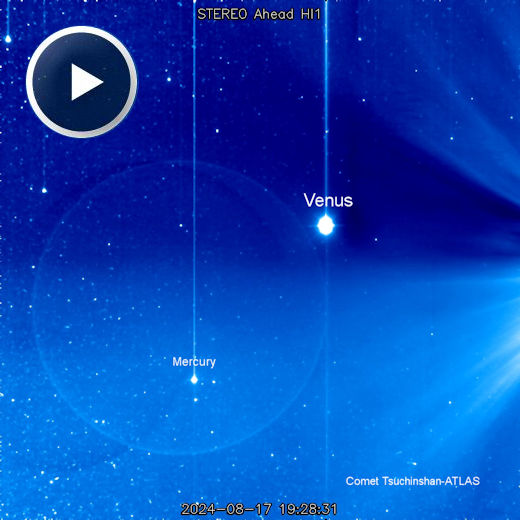 Astronomers on Earth have not been able to track the comet for weeks because of the sun's glare. STEREO-A's movie is reassurance that the comet has not broken apart despite predictions to the contrary. Astronomer Qicheng Zhang of the Lowell Observatory is optimistic about the comet's chances:"It continues to brighten steadily, and is now up to magnitude 7," he says. "It also continues to display a very robust ion tail. There are zero signs that the nucleus is disintegrating." This is good news for sky watchers. If Tsuchinshan-ATLAS can hold itself together just a little longer, it will become a naked-eye object in late Sept. and October. Zhang predicts "the comet will brighten to magnitude +4 ± 1 at perihelion on Sept. 27th, to a daylight peak of -3 ± 1 near inferior conjunction on Oct. 9th, and subsequently produce a quite possibly 20+ degree dust tail visible under dark skies (Oct ~19) before fading away." 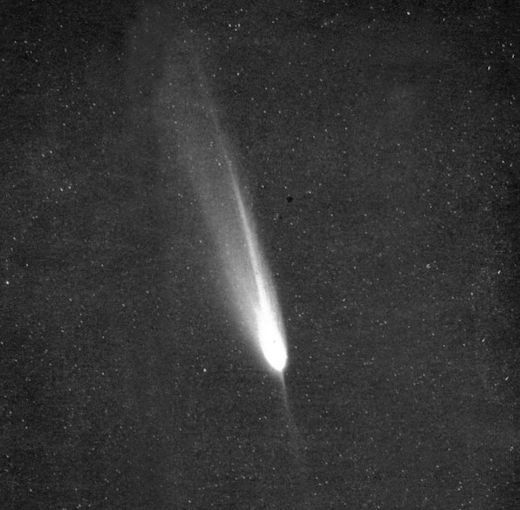 "It reminds me of the very similar Comet Arend-Roland in 1957, whose combined tails extended several tens of degrees for a few days," notes Zhang. "I consider a comparable display to be by far the most likely scenario for mid-October." The comet will re-emerge from sunlight in mid-September, becoming visible to telescopes in the southern hemisphere. How will it be doing then? Stay tuned! |
|
|
|
|
https://earthsky.org/sun/sun-news-activity-solar-flare-cme-aurora-updates/
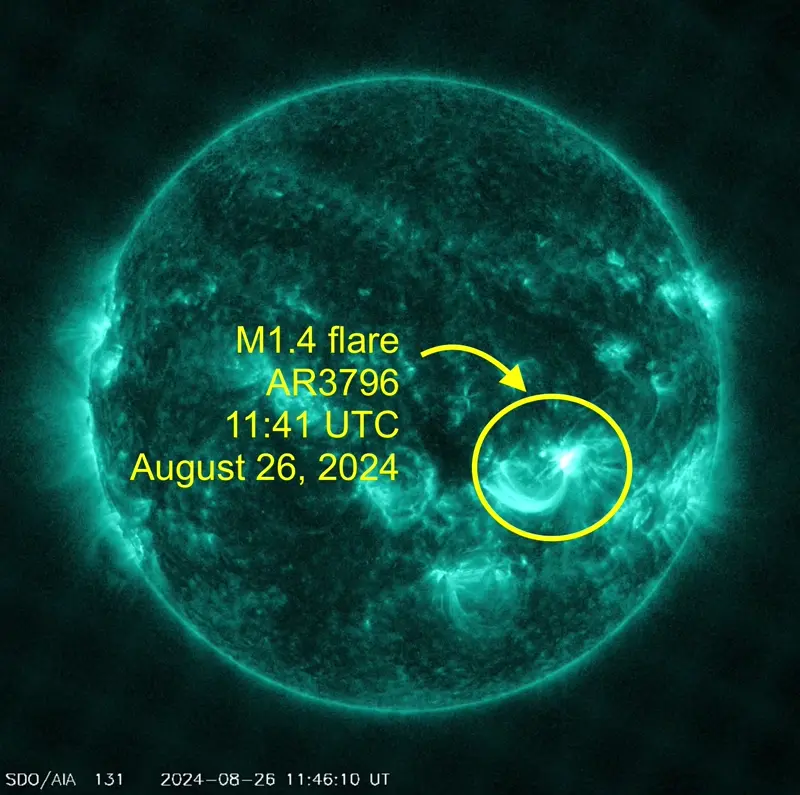 August 26, 2024 Sun activity was at moderate levels thanks to a couple of M flares during our observation period between 11 UTC yesterday and 11 UTC today. This short video shows the largest, an M1.4 flare by AR3796 at 11:41 UTC on August 26. AIA 131 angstrom. Image via SDO. Sun news August 27: AR3796 and AR3800 bring up activity Today’s top story: It has been an exciting couple of days with regions, mainly AR3796 and AR3800, going back and forth as the leading flare producer. Yesterday, there was a slight lull in M flares, and now AR3796 has taken back the lead. It has given us two small M flares, and AR3800 tried its hand with a near M, a C9.9 flare. In size and complexity, AR3796 and AR3800 are similar to their companions, AR3790, AR3799, and AR3801. Now we wait to see what the regions have in store. Will they further distinguish themselves from the group of five regions? Stay tuned. Last 24 hours: Thanks to a set of M flares sun activity increased to moderate levels. Flaring levels remained similar to the day before during our observation period from 11 UTC yesterday to 11 UTC today with 13 flares, two M and 11 C flares. The largest was an M1.4 at 11:41 UTC on August 26. It was produced by active region AR3796 in the southwest. An R1 (moderate) radio blackout affected an area over the Atlantic Ocean. The second M flare of the period was an M1.1 flare by same AR3796 blasted at 9:43 UTC on August 27. Correspondent R1 (minor) radio blackout was observed over Ethiopia. Region AR3796 remained the lead flare producer with seven of the 12 flares, including the M flares. The sun has ten active regions on its Earth-facing side. Five regions kept a beta-gamma magnetic configurations: AR3790, AR3796, AR3799, AR3800 and AR3801 though their flaring was less. The remaining regions have simple alpha or beta configurations and remain stable or are in decay. Next 24 hours: The chance for C flares is 99%. The chance for M flares is 70%. The chance for X flares is 20%. Next expected CME: No Earth-directed coronal mass ejections (CMEs) were observed in available coronagraph imagery. Current geomagnetic activity: Earth’s magnetic field is quiet at the time of this writing (11 UTC on August 27). The geomagnetic field is likely to increase to unsettled levels late today, early August 28, due the expected glancing blow of the coronal mass ejection (CME) from August 23. Mostly quiet conditions are expected through August 29, otherwise. 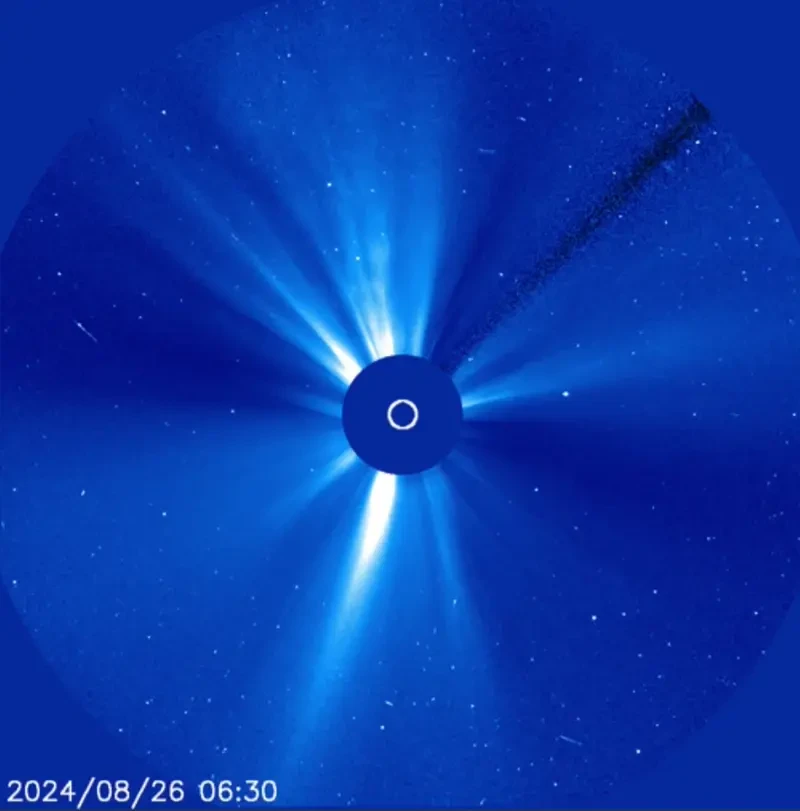 August 26, 2024. LASCO C3 captured a coronal mass ejection (CME) with shape of an electric light bulb.By the way, before the blast, there is a diving comet at the lower right of the dark blue disc at the center. Did you see it? Image via NOAA. |
|
|
|
|
August 27, 2024 @ 23:00 UTC
The Bz component of the interplanetary magnetic field has tipped into a south pointing position (-12nT). Active geomagnetic conditions (Kp4) will be possible. Minor (G1) geomagnetic storming may also be possible depending on how long it remains in this state. Aurora sky watchers at high latitudes should be alert once dark outside. |
|
|
|
|
Interesting
|
|
|
|
|
I love the idea of a daylight visible comet. That would be awesome! Thanks again for making this thread and keeping it up.
|
|
|
|
|
https://spaceweather.com/
CME IMPACT SPARKS GEOMAGNETIC STORM: Yesterday, Aug. 27th, a CME struck Earth. At first, the CME's impact appeared weak and, indeed, it did not cause an immediate geomagnetic storm. However, during the early hours of Aug. 28th, magnetic fields in the CME's wake linked to Earth's magnetic field, causing storms of category G2. Auroras were photographed in Europe and the USA. CME impact alerts: SMS Text "This morning, on August 28, 2024, around 1 AM (UTC) faint auroras appeared over the Czech Republic," reports Petr Horálek, who sends this picture from the shore of Seč Lake: 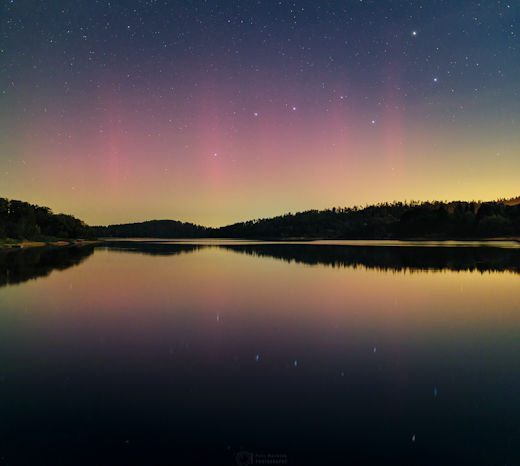 "What a year, so many auroras from central Europe have not been visible since 2001!" he says. more images: from Oliver Schwenn of Skagen, Danmark; from Jeremy Rogers in the Pawnee National Grasslands of Weld County, Colorado; from Calvin Cannon of Madras, Oregon |
|
|
|
|
https://earthsky.org/sun/sun-news-activity-solar-flare-cme-aurora-updates/
 Sun news for August 27-28, 2024. Sun activity was reflected in Earth’s magnetic field by causing a G2 (moderate) geomagnetic storm early on August 28 and a G1 (minor) storming at the time of writing this article. Similar conditions of a G1 storming may continue during the day. That means good chances for auroral displays. Image via NOAA. Sun news August 28: Auroras! More to come? Today’s top story: A stronger-than-expected geomagnetic storm began today (UTC) shortly after a weak shock wave due to the August 23 coronal mass ejection (CME) delivered a glancing blow at Earth. A G1 storm started around 2:12 UTC, then a G2 around 3 UTC, calming to a G1 around 7 UTC. We are now back to active levels. These geomagnetic conditions provided an opportunity to observe auroras to lower latitudes, such as the northern boundaries of US states like Oregon and Wyoming in the US and down to Dombås in Norway. Did you see the auroras? Captured a photo? Share! Could this geomagnetic activity continue? We have a chance for more G1 storming. Alert for Aurora Chasers. Stay tuned. Last 24 hours: Solar activity dropped to low levels during the past day with only C flares. During our observation period from 11 UTC yesterday to 11 UTC the sun produced five C flares. The largest event was a C5.1 flare at 15:45 UTC on August 27 from sunspot region AR3800. The sun has eight active regions. Four regions retained a beta-gamma magnetic configurations: AR3790, AR3796, AR3799 and AR3800 and the rest show an alpha or beta configuration. All remain stable with low flare productivity. This lull in activity may seem very strange given that the sun is currently in the part of its activity cycle called solar maximum. This is a normal part of the 11-year cycle solar cycle. Solar maximum doesn’t mean the sun is in a continuous state of high activity but that it experiences days or weeks of high activity with small lulls in between, and the periods of activity are stronger. Activity is more than just flaring. We are seeing some very exciting, energetic prominence activity. A prominence on the eastern limb erupted, uncurling as it left the sun. This produced a beautiful CME visible in the SOHO LASCO C2 and C3 coronagraphs. Two dynamic but currently stable prominences on the west-northwest limb (edge) are dancing high in the solar atmosphere. Next 24 hours: The chance for C flares is 90%. The chance for M flares is 70%. The chance for X flares is 20%. Next expected CME: No Earth-directed coronal mass ejections (CMEs) were observed in available coronagraph imagery. Current geomagnetic activity: Earth’s magnetic field is active with a G1 (minor) geomagnetic storm ongoing at the time of this writing (11 UTC on August 28). The G1 threshold was reached at 7:05 UTC on August 28. Earlier today the geomagnetic field was disturbed to a Kp = 6 level, that is a G2 (moderate) geomagnetic storm. These conditions of active levels are expected to continue for the rest of the day through tomorrow, August 29. This activity is due to the arrival yesterday, August 27, of the glancing blow of the coronal mass ejection (CME) from August 23. Only active conditions or a G1 geomagnetic storm was expected but the CME hit was stronger than expected. 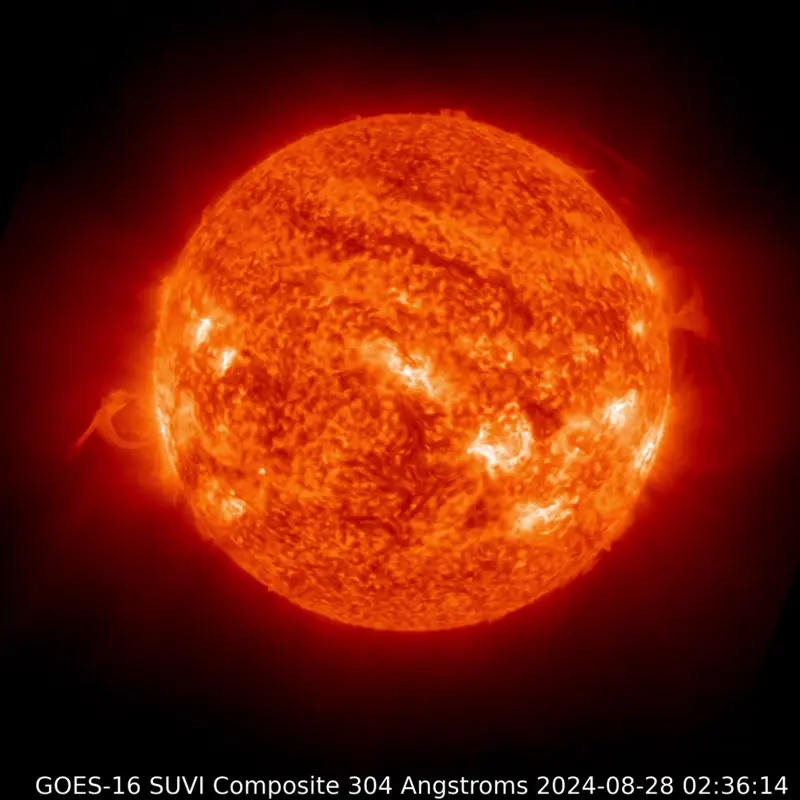 August 28, 2024. Sun activity is low today with five C flares but the action is on the solar limb. The pine-tree-lookalike prominence we saw yesterday ended in a gorgeous colossal prominence hurling ejecta into space. Meanwhile, the one we saw in the northwest got stronger, occupying almost the whole edge of the northwest quadrant. GOES-16 SUVI 304 angstrom. Image via NOAA. 
|
|
|
|
|
https://spaceweather.com/
MASSIVE CME TARGETS VENUS: A solar magnetic filament erupted yesterday, hurling a bright CME into space. It won't hit Earth. Instead the CME is heading for Venus. A NASA model predicts it will strike the second planet on Aug. 30th. The impact will erode a small amount of atmosphere from Venus's unprotected cloudtops. CME impact alerts: SMS Text CATCHING A CME BY THE TAIL: CMEs have tails, and they can be very good at whipping up geomagnetic storms. Consider this week's example. On Aug. 27th, a seemingly feeble CME hit Earth's magnetic field. At first, nothing happened. Then, on Aug. 28th, Earth encountered the CME's tail and a G2-class storm erupted: 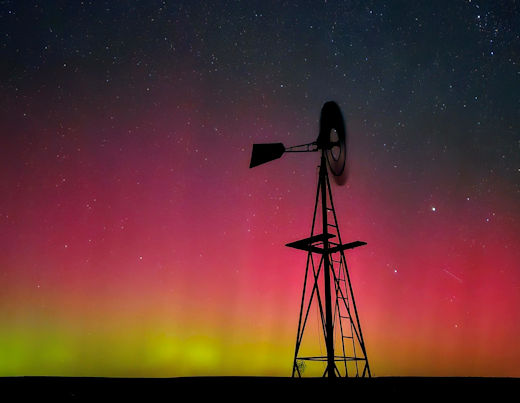 "Here in Colorado, red auroras were visible to the naked eye," reports Jeremy Rogers from the Pawnee National Grasslands. "The pillars were visibly dancing." The storm and light show occured more than 10 hours after the CME arrived. At the time, Earth was deep inside the CME's tail--a magnetized structure trailing the CME itself. Magnetic fields within the tail unexpectedly connected to our planet's magnetosphere. The storm commenced and auroras were sighted across Europe and the USA as far south as latitude +41N. CME impact alerts: SMS Text more images: from Sujay Singh of northeastern Pennsylvania; from Christopher Mathews of Hraunborgir, Iceland; from Rocky Raybell of Keller, Washington; from Aaron Watson in the West Elk Mountains of Colorado; from Troy Bryan of Scottsbluff, Nebraska |
|
|
|
|
https://earthsky.org/sun/sun-news-activity-solar-flare-cme-aurora-updates/
Sun news August 29: A second hit reached G2 level. Did you see the auroras? 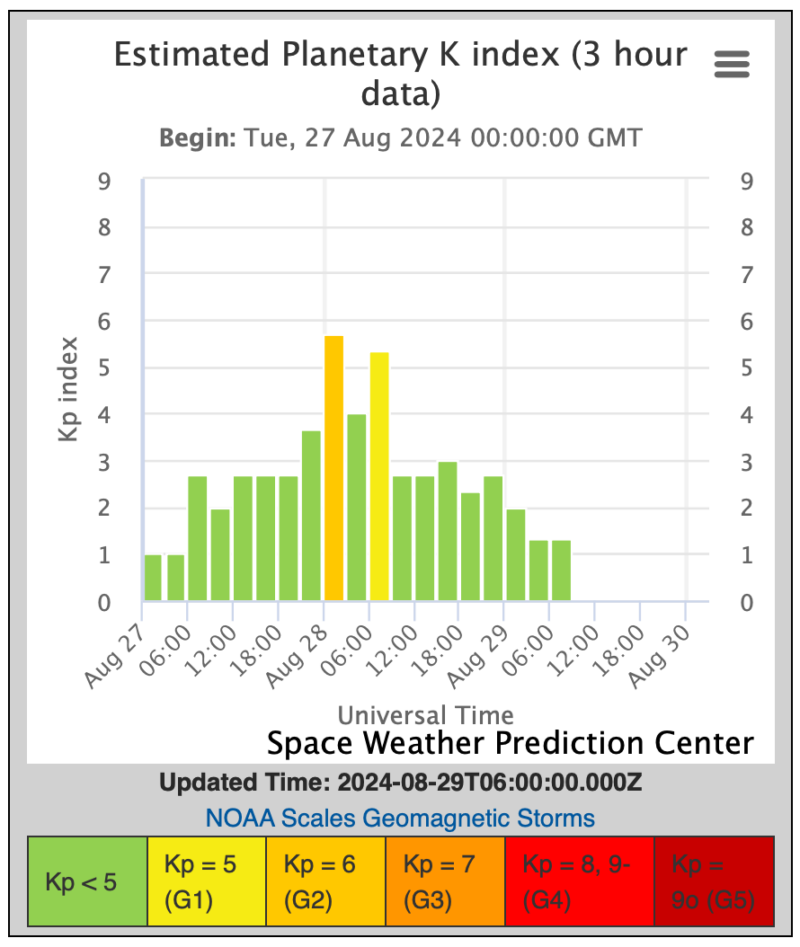 August 29, 2024 A surprising second hit from the glancing blow from a coronal mass ejection (CME) hurled by the sun on August 23 provoked G1(minor)-G2(moderate) geomagnetic storming earlier today. Image via NOAA. Today’s top story: The glancing blow surprised for a second time earlier today. A G2 (moderate) geomagnetic storm was observed. The Kp = 6 threshold was reached at 0:03 UTC and reduced to G1 (minor) or Kp = 5 at 6 UTC. Did you see the auroras? Bring them on! We want to see your beautiful photos. Meanwhile the sun sun activity is the periphery. A strong long lasting prominence dancing on the northwest limb (edge) adorned the whole period. Despite the solar activity at low levels with only C flares, there is solar activity on the Earth facing side of our sun. We saw a couple of exploding filaments hurling ejecta into space, one on the northwest quadrant and another in the vicinity of AR3799. These small coronal mass ejections combined with fast solar wind can give us a surprise as the glancing blow we just saw that hit twice. There is long transequatorial filament crossing from the northeast quadrant thru the northwest reaching the southwest. We have seen long filaments like this one exploding in gorgeous plasma lifting prominences. We will keep observing this one. Stay with us as we will bring you more sun news. Last 24 hours: Only C flares produced in the past day keep solar activity at low levels. A slight increase in flaring productions makes a little difference compared to the previous day. During our observation period from 11 UTC yesterday to 11 UTC the sun produced a total of nine C flares compared to five C flares yesterday. There were two events to be taken as the largest event, both C7.0 flares. The first one at 20:38 UTC on August 28 blasted out by active region AR3801 and the second C7.0 at 4:18 UTC on August 29 produced by AR3806. This same sunspot region, AR3806 reached the level of lead flare producer of the period with six flares. Currently the sun The sun has nine active regions on its Earth-facing side. There is a newcomer on the east limb (edge) now numbered AR3806. Three regions show a beta-gamma magnetic configurations: AR3796, AR3799 and AR3800 and the rest show an alpha or beta configuration. All stable, in decay or with low flare productivity. Activity is more than just flaring. We are seeing some very exciting, energetic prominence activity. A prominence on the eastern limb erupted, uncurling as it left the sun. This produced a beautiful CME visible in the SOHO LASCO C2 and C3 coronagraphs. Two dynamic but currently stable prominences on the west-northwest limb (edge) are dancing high in the solar atmosphere. Next 24 hours: The chance for C flares is 99%. The chance for M flares is 55%. The chance for X flares is 10%. Next expected CME: No Earth-directed coronal mass ejections (CMEs) were observed in available coronagraph imagery. Current geomagnetic activity: Earlier today, a G2 (moderate) geomagnetic storm was observed. Threshold reached at 0:03 UTC. The disturbance returned to G1 (minor) levels at 6 UTC. All this caused by the lingering effect of a coronal mass ejection hurled by the sun on August 23. Earth’s magnetic field returned to quiet level and is quiet at the time of this writing (11 UTC on August 29) and is expected to continue at low levels extended thru August 30 as the CME effects wane. There are three coronal holes forming. The fast solar wind they produce may start to reach us at Earth in the next couple of days. |
|
|
|
|
https://earthsky.org/sun/sun-news-activity-solar-flare-cme-aurora-updates/
Sun news August 30: Geomagnetic disturbance continues! Today’s top story: The unexpectedly strong geomagnetic activity of the past few days is continuing, following Earth’s glancing blow from a blob of sun-stuff on Wednesday. A Kp = 4 disturbance is ongoing at the time of this writing (11 UTC, August 30). These conditions may have brought auroral displays to northern locations such as Tromsø in Norway and Alaska in the US. And luckily, it was dark in northern areas of the US at the time of the disturbance. Did you see any auroras? Show us your photos! And don’t forget to join us in our live stream today at 12:15 p.m. EDT (17:15 UTC), where we’ll be discussing some exciting solar news. Don’t miss it! Last 24 hours: Sun activity is back to moderate thanks to an isolated M flare from sunspot region AR3806 in the southeast quadrant. The blast occurred at 2:06 UTC on August 30 and caused an R1 (minor) radio blackout that affected an area where the Pacific Ocean and the Philippine Sea meet. This sunspot region, AR3806, just rotated into view yesterday. And now that we can see it fully for a better analysis, specialists found a delta region in its magnetic configuration; it bears the most complex beta-gamma-delta configuration, meaning it has the potential for more M flares and even X flares. Between 11 UTC yesterday and 11 UTC today, our observation period, the sun produced a total of 12 flares: the aforementioned M and 11 Cs. The lead flare producer of the period was active region AR3806, which sparked five flares: four C flares and the M. The sun currently bears eight labeled sunspot regions on its Earth-facing side. There is a newcomer in the southeast quadrant now numbered AR3807, which is showing a beta-gamma configuration. The rest of the visible sunspot groups have simple alpha or beta configurations and look stable or in decay. Next 24 hours: The chance for C flares is 99%. The chance for M flares is 60%. The chance for X flares is 10%. Next expected CME: No Earth-directed coronal mass ejections (CMEs) were observed in available coronagraph imagery. Current geomagnetic activity: Earth’s magnetic field is active at the time of this writing (11 UTC on August 30). A Kp = 4 disturbance is ongoing as we write this report. This threshold was reached at 8:52 UTC. Quiet levels are anticipated for August 30. |
|
|
|
|
https://spaceweather.com/
POTENTIALLY DANGEROUS SUNSPOT: New sunspot AR3806 has a 'delta-class' magnetic field that poses a threat for strong X-class solar flares. Any explosions this weekend will be geoeffective as the sunspot is turning to face Earth. Solar flare alerts: SMS Text A CRACK IN EARTH'S MAGNETIC FIELD: During the late hours of Aug. 30th, a crack opened in Earth's magnetic field. Solar wind flowed through the gap, sparking a G1-class geomagnetic storm with auroras in both Europe and the USA. P-M Hedén sends this picture from Vallentuna, Sweden:  "Last night brought another fantastic display to my home town," says Hedén. "Such a show in colors - love it!" Sightings were also reported in Estonia ("unusually bright!"), southeast England ("the 17th night this year!"), Wisconsin, Minnesota, Washington State and even Nebraska! What caused the crack to open? It might have been a fragment of a CME's tail--the same CME that caused an even stronger storm on Aug. 28th. Aurora alerts: SMS Text |
|
|
|
|
https://spaceweather.com/
SATURN AT OPPOSITION: This is the weekend of Saturn. On Sunday, Saturn 8th, the ringed planet will be at its closest to Earth for the entire year, and a marvelous sight through small telescopes. Look for it shining about as brightly as a 1st magnitude star high in the sky at midnight in the constellation Aquarius. A PUFF OF DARK PLASMA IS HEADING FOR EARTH: A filament of magnetism erupted on the Sun Sept 8th. The blast hurled a coil of cool dark plasma toward Earth: 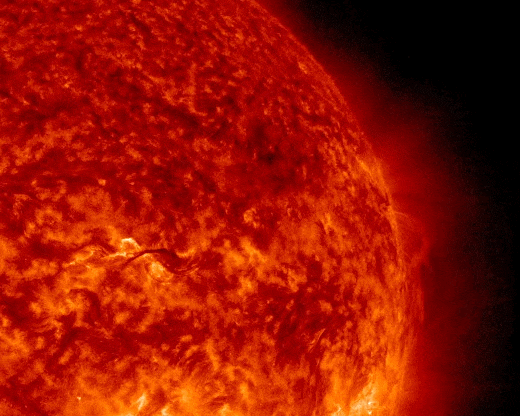 NASA's Solar Dynamics Observatory recorded the explosion. The departing plume ripped a hole in the sun's atmosphere and formed the core of a coronal mass ejection (CME). NOAA models suggest that the CME will reach Earth late on Sept. 10th, potentially sparking a G2-class geomagnetic storm. During such storms, auroras can typically be seen (naked-eye) in northern-tier US states such as Minnesota and Wisconsin. Cameras (including smartphone cameras) can detect them even farther south in rural areas of states like Nebraska, Colorado and Missouri. CME impact alerts: SMS Text |
|
|
|
|
https://earthsky.org/sun/sun-news-activity-solar-flare-cme-aurora-updates/
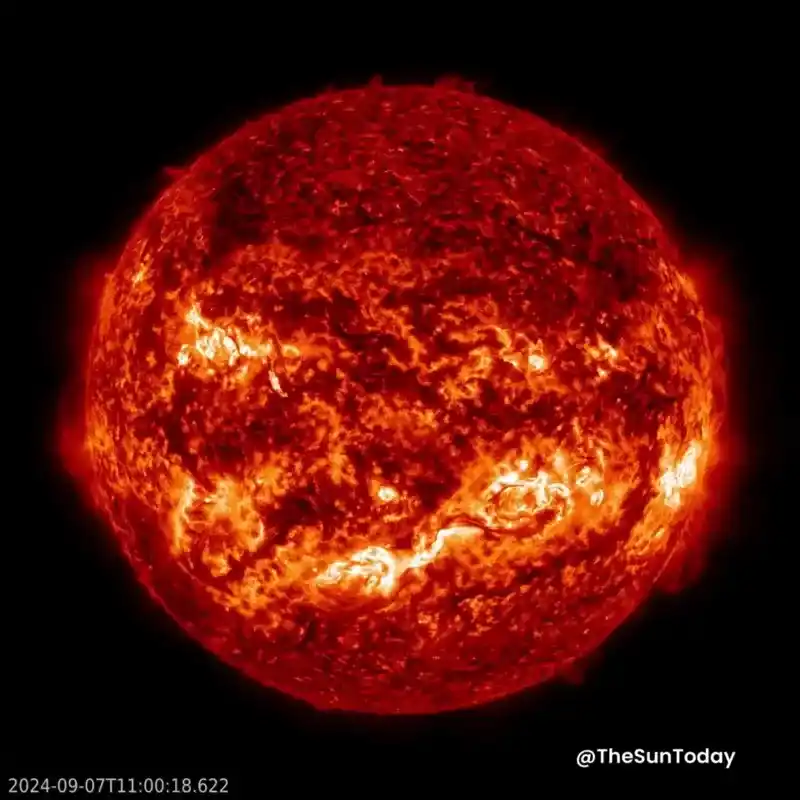 Sun news September 8: A dark filament eruption Happy Sun Day! For many, today is a day for relaxing and stepping into some downtime. The sun is taking this seriously. The flaring size and rate is low. We also have no new Earth-directed coronal mass ejections (CMEs). But the filament eruption yesterday – associated with an M flare and region AR3813/15 – might give Earth a glancing blow on September 11. NASA models say yes on this possibility, but NOAA models say no (see below). We will have to wait and see. The most exciting action today is from a nice, dark filament eruption. The eruption comes from just northwest of disk center. We can see a bright ribbon on the sun after the filament launches. As the filament flys away from the sun it looks like a shadow moving away. It is dark because the material is cooler than the sun behind it. We on’t yet know if any of the sun stuff will head our way. Stay tuned! Last 24 hours: It is a day of low activity, with only C flares. During our observation period (11 UTC yesterday to 11 UTC today), our star produced nine C flares. This is a reduction in flaring rate in contrast with the last several days. There’s no longer any region on the Earth-facing sun now with a delta magnetic complexity, indicative of strong flare potential. Regions AR3806, AR3811, AR3813, and AR3815 have beta-gamma magnetic complexity. All these regions have an increased potential for producing M or X flares, but not as much so as a beta-gamma-delta region. The sun now has eight sunspot regions on its Earth-facing disk, including two newcomers, AR3818 and AR3819. Next 24 hours: The chance for C flares is 99%. The chance for M flares is 55%. The chance for X flares is 15%. Next expected CME: No Earth-directed coronal mass ejections (CMEs) were observed in available coronagraph imagery. Current geomagnetic activity: Earth’s magnetic field is quiet at the time of this writing (11 UTC on September 8). High-speed solar wind from a coronal hole is expected to move into a geoeffective position today elevating conditions to unsettled. This should extend into September 9. Conditions will return to mostly quiet on September 10. |
|
|
|
|
September 9, 2024 @ 08:45 UTC
Two more coronal mass ejections to report. The first event was related to activity off the west limb and appears to be directed away from Earth. A proton enhancement reaching the minor (S1) radiation storm threshold is being detected and may have been related to this event. Of more interest, yet another large halo CME off the farside of the Sun is now visible and it originated beyond the east limb around 05:00 UTC (Sep 9). It is possible that the source could be the same region that produced energetic farsided events on Sept 3 and 5. Click HERE for evidence of the eruption behind the east limb. 
|
|
|
|
|
https://spaceweather.com/
A PUFF OF DARK PLASMA IS HEADING FOR EARTH: A filament of magnetism erupted on the sun yesterday, hurling a coil of cool dark plasma toward Earth. A NOAA model suggests it will arrive during the late hours of Sept. 10th. The impact could spark a G2-class geomagnetic storm with naked-eye auroras in northern-tier US states. CME impact alerts: SMS Text SOLAR SAIL SIGHTINGS: NASA's Advanced Composite Solar Sail System (ACS3) is circling Earth in full view of observers around the world. Zdenek Bardon photographed it cutting through the Milky Way over the Czech republic on Sept. 7th: 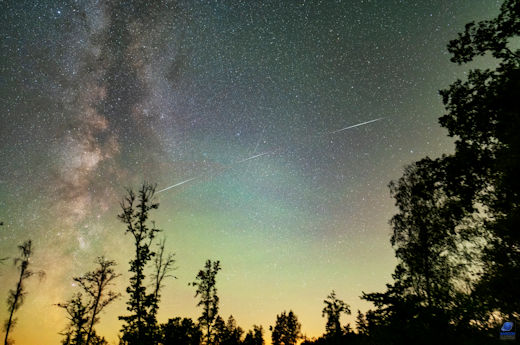 The brightness variations in Bardon's photo confirm that the sail is tumbling. Believe it or not, this is intentional. The sail was unfurled on Aug. 24th without attitude control. NASA's is learning how to maneuver a sail under these conditions. Soon, attitude control will be imposed for further testing. Until then, the sail's brightness will vary from naked-eye invisibility to slow flares rivaling the brightest stars in the sky. Would you like to see the solar sail? Local flyby predictions may be found on Heavens Above. Tip: Scroll down the website and look here for "ACS3." more images: from Gorazd Bizjan of Medvode, Slovenia; from Scott Tucker of Tucson, Arizona; from Ron Myers of Sacramento, California; |
|
|
|
|
https://earthsky.org/sun/sun-news-activity-solar-flare-cme-aurora-updates/
 Sun news September 9: Activity is picking up Today’s top story: After a quiet weekend, things are picking up. Over the past 24 hours (11 UTC yesterday to 11 UTC today), we’ve had four M flares (moderately strong flares), along with nine C-class (lesser) events. Also, one of the flares just over the sun’s western limb (edge) – either AR3806 or AR3807 – caused a solar particle event, also known as a radiation storm. This is an event in which solar particles, mostly protons, become accelerated in the sun’s atmosphere. The M1.1 flare causing the event happened around 3:30 UTC on September 9. High energy protons reached S1 (minor) radiation storm levels. At the time of this writing (11 UTC on September 9), the solar particles are causing additional radio communications disruptions near the North and South Poles on Earth. The flare and particle event had an associated eruption, producing a coronal mass ejection (CME) toward the west. The CME does not appear to have an Earth-directed component, but we await additional coronagraph imagery. Another eruption occurred off the sun’s northeast limb (edge), just behind the limb. This event, also, doesn’t to have an Earth-directed component, but we will need to wait for more data. Stay tuned. Last 24 hours: Activity has picked up in the last 24 hours, reaching moderate levels, with four small M flares. It is difficult to determine exactly which active region is the source for the flares on the sun’s limb, because two regions are just over the southwest limb (edge): AR3806, AR3807, and AR3808. These regions produced three of the four flares including the one with the associated solar particle event and radiation storm. The sun produced 13 flares, four M and nine C flares. The list of M flares is: • M1.6 at 15:30 UTC on September 8 from AR3811. R1 (minor) radio blackout over the northeastern tip of South America. • M1.0 at 03:31 UTC on September 9 from AR3806/07/08. R1 (minor) radio blackout over Indonesia. • M1.9 at 05:45 UTC on September 9 from AR3806/07/08. R1 (minor) radio blackout over Southeast Asia. • M1.5 at 08:50 UTC on September 9 from AR3806/07/08. R1 (minor) radio blackout over East Africa. • M1.5 at 08:50 UTC on September 9 from AR3806/07/08. R1 (minor) radio blackout over East Africa. Only AR3811 and AR3814 have beta-gamma magnetic complexity. The sun has nine regions on the disk. Next 24 hours: The chance for C flares is 99%. The chance for M flares is 55%. The chance for X flares is 10%. Next expected CME: No Earth-directed coronal mass ejections (CMEs) were observed in available coronagraph imagery. Current geomagnetic activity: Earth’s magnetic field is quiet at the time of this writing (11 UTC on September 9). High-speed solar wind from a coronal hole is expected to elevate conditions from quiet to unsettled, with active periods. September 10 we should see G2 (moderate) storm conditions due to the arrival of a coronal mass ejection (CME) that occurred from a filament eruption on September 8. Elevated conditions are likely to persist into September 11, with G1 (minor) storm conditions possible during the first half of the day. |
|
|
|
|
This is a lot of activity compared to the rest of the past decade where there was like one of these a month, now they are twice a week at times.
The end is nigh! Or it is just the peak of the solar cycle. |
|
|
The person who complains most, and is the most critical of others has the most to hide.
All truth passes through three stages. First, it is ridiculed. Second, it is violently opposed. Third, it is accepted as being self-evident. |
|
If some catastrophic event happens and most of humanity is wiped from the face of the earth, the only people left to hang out with will be you guys! Oh the horror! -- Boombastic
No situation is ever so bad that the government can't make it worse. |
 Solar Eruptions (9/9/2024) - SolarHam.com |
|
|
|
|
https://spaceweather.com/
A PUFF OF DARK PLASMA IS HEADING FOR EARTH: A filament of magnetism erupted on the sun yesterday, hurling a coil of cool dark plasma toward Earth. A NOAA model suggests it will arrive during the late hours of Sept. 10th. The impact could spark a G2-class geomagnetic storm with naked-eye auroras in northern-tier US states. CME impact alerts: SMS Text FARSIDE EXPLOSION CAUSES RADIATION STORM: Protons are raining down on Earth today following an explosion on the farside of the sun. It's an S1-class solar radiation storm. The farside blast hurled a magnificent CME into space, recorded by the Solar and Heliospheric Observatory (SOHO): 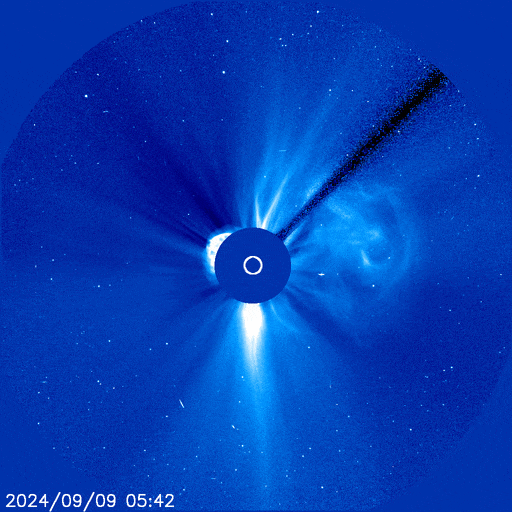 Shockwaves in the leading edge of the CME accelerated the protons and scattered them throughout the solar system--even toward Earth on the opposite side of the sun. Our planet's magnetic field is capturing the particles and funneling them toward the poles, where they are causing a polar cap absorption event (PCA): 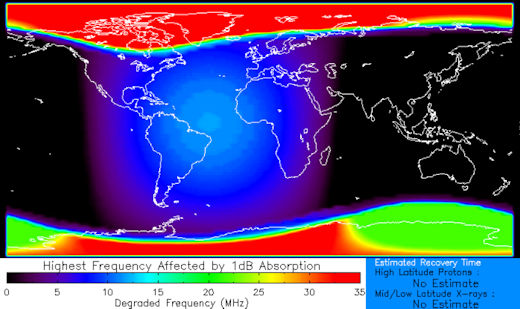 Within the red shaded areas, shortwave radio transmissions are blacked out. Frequencies below 30 MHz are most strong affected. Who cares? Pilots flying international routes over the poles may notice that onboard shortwave radios don't work for the duration of their Arctic transit. This radiation storm could last for another 24 hours or more. Stay tuned. Radiation storm alerts: SMS Text |
|
|
|
|
https://earthsky.org/sun/sun-news-activity-solar-flare-cme-aurora-updates/
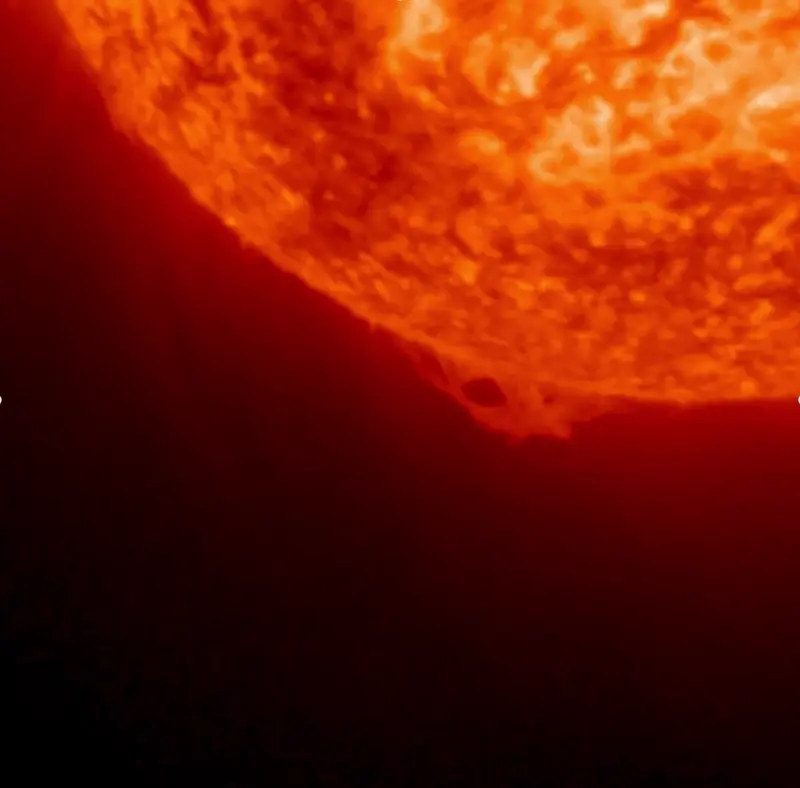 Sun news September 10: Storms and filaments Today’s top story: Sun activity has been moderate in the past day (11 UTC yesterday to 11 UTC today), with three M flares. And we’re having fun watching filaments on the sun’s disk – glowing ropes of solar material and magnetic fields, arcing up from the sun’s visible surface – as we wait today for possible geomagnetic storms at Earth. The sun’s disk is covered with filaments now, which could bring some eruptions. We also see prominences – the same thing as filaments, but seen on the sun’s limb (edge) – extending into space from the sun’s north and south poles. Meanwhile, a coronal mass ejection (CME) that left the sun on September 8 is expected at Earth today. This anticipated arrival should bring geomagnetic storms at the level of G1 to G2 (mild to moderate). Depending on when the CME arrives – and which part of Earth is experiencing darkness at that time – you might get auroras. Get your aurora watching gear ready, and stay tuned. Last 24 hours: Solar activity is moderate. In the last 24 hours the sun produced nine flares, three M and six C flares. The largest was an M3.4 at 17:08 UTC on September 9 from active region AR3814. The blast caused an R1 (minor) radio blackout affecting an area over the Caribbean Sea off the north coast of Colombia. The list of M flares is: • M1.0 at 12:17 UTC on September 9 from AR3811. R1 (minor) radio blackout over Ghana. • M3.4 at 17:08 UTC on September 9 from AR3814. R1 (minor) radio blackout over the Caribbean Sea off the north coast of Colombia. • M1.2 at 0:16 UTC on September 10 from AR3814. R1 (minor) radio blackout over the Pacific Ocean. Only sunspot region AR3814 kept its beta-gamma magnetic complexity. The remaining labeled active regions show simpler alpha and mostly beta configurations. The sun has nine sunspot regions on its Earth-facing side. We welcomed a newcomer, AR3822. It emerged in the northeast quadrant east of AR3814. Two large coronal holes also emerged on the Earth-facing side of our star, one in the northeast quadrant and the second in the southeast. Next 24 hours: The chance for C flares is 99%. The chance for M flares is 55%. The chance for X flares is 15%. Next expected CME: No Earth-directed coronal mass ejections (CMEs) were observed in available coronagraph imagery. Current geomagnetic activity: Earth’s magnetic field is quiet at the time of this writing (11 UTC on September 10). The arrival of a coronal mass ejection (CME) that occurred from a filament eruption on September 8 might bring G1-G2 (minor-moderate) geomagnetic storm conditions anticipated for later today. This combined with high-speed solar wind from a coronal hole might create conditions for auroral displays at northern latitudes, perhaps as far south as the northern U.S. states of New York, Washington and Wisconsin. Alert for aurora chasers. Clear skies to you! |
|
|
|
|
|
|
Can you explain to me like I'm dumb? What are the conditions I should look for to know that aurora activity will be particularly good?
Flare class? Geomagnetic activity? Etc... |
|
|
|
|
Originally Posted By Torque556: Can you explain to me like I'm dumb? What are the conditions I should look for to know that aurora activity will be particularly good? Flare class? Geomagnetic activity? Etc... View Quote @Torque556 https://www.swpc.noaa.gov/ |
|
|
The person who complains most, and is the most critical of others has the most to hide.
All truth passes through three stages. First, it is ridiculed. Second, it is violently opposed. Third, it is accepted as being self-evident. |
 Win a FREE Membership!
Win a FREE Membership!
Sign up for the ARFCOM weekly newsletter and be entered to win a free ARFCOM membership. One new winner* is announced every week!
You will receive an email every Friday morning featuring the latest chatter from the hottest topics, breaking news surrounding legislation, as well as exclusive deals only available to ARFCOM email subscribers.
AR15.COM is the world's largest firearm community and is a gathering place for firearm enthusiasts of all types.
From hunters and military members, to competition shooters and general firearm enthusiasts, we welcome anyone who values and respects the way of the firearm.
Subscribe to our monthly Newsletter to receive firearm news, product discounts from your favorite Industry Partners, and more.
Copyright © 1996-2024 AR15.COM LLC. All Rights Reserved.
Any use of this content without express written consent is prohibited.
AR15.Com reserves the right to overwrite or replace any affiliate, commercial, or monetizable links, posted by users, with our own.

